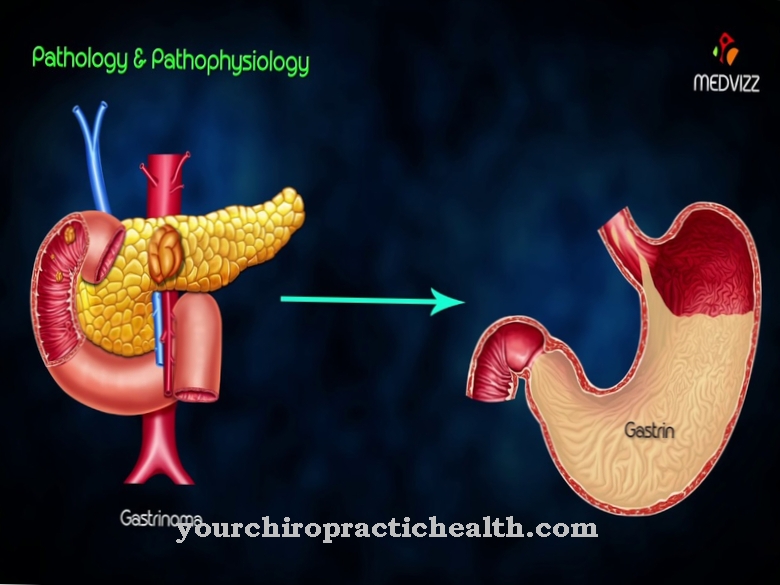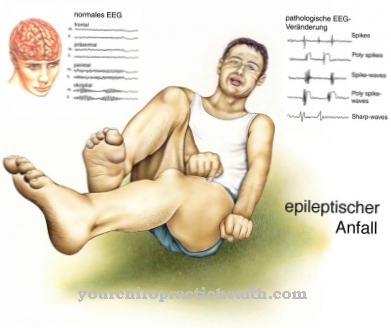The arteries and veins are central blood-carrying systems which supply the entire human organism with nutrients and oxygen and remove toxic metabolic end products. Due to a number of external and internal factors, a arterial hypertension arise, which can affect all organs.
What is arterial hypertension?

Arterial hypertension is a disease that affects the arteries and manifests itself as high blood pressure with its specific symptoms. If the blood pressure is measured, a systolic value of more than 140 mmHg occurs in arterial hypertension.
The second parameter, diastolic blood pressure, is over 90 mmHg. Arterial hypertension is classified as primary and secondary hypertension according to their causative factors.
In addition, there are other classification systems for arterial hypertension, which were established by the World Health Organization and the Working Group of the Scientific Medical Association e.V.
causes
There are many causes of arterial hypertension. In the primary form, they contain the so-called essential criteria or physical triggers.
For secondary hypertension, there are triggers such as diseases of the kidneys and individual glandular systems. Various diseases that lie directly in the vessels themselves can also contribute to arterial hypertension. These are, for example, inflammation of the vessels and abnormal abnormalities of the heart. Various tumor diseases, arteriosclerosis and especially toxins can equally cause high blood pressure.
Arterial hypertension can also be observed during pregnancy and as a result of drug use and in conjunction with the intake of individual medicinal products. Raised blood pressure can also occur with Cushing's syndrome, physical obesity and angina pectoris.
Symptoms, ailments & signs
Arterial hypertension manifests itself in various physical and mental symptoms. At the beginning, affected people feel a general reduction in well-being. There is increased weariness and weakness, but also phases of increased activity. In the further course, problems with balance and morning headaches occur, which are particularly intense after lying down for a long time.
The cardiovascular system is also affected: palpitations, cardiac arrhythmias and circulatory problems are the result. The increased heartbeat can cause anxiety and panic attacks, which are expressed in nervousness, sweating and generally a strong feeling of malaise. It can also cause nausea and vomiting. Some people suffer from dizziness, impaired consciousness, fatigue and insomnia.
Outwardly, arterial hypertension manifests itself, among other things, through a reddened face and clearly visible veins. The increased blood pressure also leads to nosebleeds and can also cause other symptoms. The circulatory disorders cause numbness and tingling in the arms and legs.
If the blood pressure is very high, visual disturbances, angina pectoris and breathing difficulties and even shortness of breath can occur. The feeling of thirst increases and the person concerned has to urinate more often. Overall, the physical and mental resilience drops significantly.
Diagnosis & course
Arterial hypertension is characterized by symptoms that are initially expressed in a general reduction in the physical condition. The patients complain of permanent fatigue and weakness as well as disturbances of the balance and morning headaches. These are typical for one, especially after lying down for a long time.
If there is an extreme increase in blood pressure in the case of arterial hypertension, shortness of breath occurs during physical exertion and impaired vision. Irregularities of the heart, which manifest themselves in an abnormal heartbeat, are quite common. The heart is racing, does not beat steadily and can sometimes beat heavily.
Parasitic sensations in the terminal areas of the body are also classic in high blood pressure. The circulatory disorders lead to a feeling of numbness or tingling.
When should you go to the doctor?
Since arterial hypertension can cause damage to blood vessels and organs at an early stage, it can only be advised to see a doctor as early as possible. After all, irreversible long-term effects can only be avoided through drug therapy for the high blood pressure. Arterial hypertension is an insidious disease because it usually does not cause any symptoms at all, especially at the beginning, which is why the doctor is consulted too late in many cases, namely when visible damage to organs or vessels can already be identified.
Even healthy people should have their blood pressure measured at least once a year, even if they have not yet had any symptoms that indicate hypertension. Because the discovery of arterial hypertension is often an incidental finding. The blood pressure measurement can be done in the pharmacy but also on your own at home with a handheld measuring device or upper arm measuring device suitable for this purpose. As soon as systolic values of 140 and diastolic values of 90 mmHg are exceeded during a self-measurement of the blood pressure, the doctor should be consulted immediately.
For patients with previous damage to the heart or kidneys, the limit values for avoiding arterial hypertension are set even lower. If arterial hypertension is not treated in good time, hypertensive crises with damage to blood vessels and organs or heart attacks and strokes can result.
Doctors & therapists in your area
Treatment & Therapy
The clinical picture of the disease is not always the same in arterial hypertension. The treatment of high blood pressure depends on the individual complaints and on the measured blood pressure values. In addition to general medical methods and a change in lifestyle, therapy includes drug treatment and specific interventions.
Reducing body weight, abstaining from alcohol and nicotine and restricting fatty foods are initially important in arterial hypertension. The intake of omega-3 fatty acids can also lower high blood pressure.
When it comes to drug treatment, the treating physicians prescribe drugs from the groups of ACE inhibitors, beta blockers, diuretics and calcium channel blockers. The active ingredients contained in it favor a reduction in blood pressure that is too high in the case of diagnosed arterial hypertension.
Modern medical approaches also include advanced vaccine substances and alternative treatment concepts such as so-called renal denervation and stimulation with baroreceptors.
Outlook & forecast
The prognosis for arterial hypertension depends on whether the patient suffers from primary or secondary hypertension and how long the increased blood pressure has existed.
If hypertension is diagnosed early and appropriate treatment initiated, the outlook is very good. In this case, vessels and organs are usually not yet damaged. The prognosis is also influenced by an improvement in one's own lifestyle. These include, for example, a healthy diet, weight loss, adequate exercise or smoking cessation. If the disease goes unnoticed for a long time, consequential damage to blood vessels and organs can occur.
In the early stages, hardening of the arteries can still be treated well, later therapy is only aimed at preventing the disease from progressing. As a further consequence, arteriosclerosis can lead to a heart attack, stroke, visual disturbances, kidney failure or an abdominal aortic aneurysm. The longer there is untreated, elevated blood pressure, the more likely damage to organs and vessels will occur.
If blood pressure can be normalized, the risk of suffering a stroke or heart attack is reduced by 20 percent. It is also very important to have regular check-up intervals with the doctor, who will determine whether the blood pressure is in the healthy range.
prevention
Prevention of arterial hypertension is feasible with a healthy lifestyle including regular exercise.
Avoiding alcohol and nicotine also plays an important role in prophylaxis against high blood pressure. Continuous medical check-ups for drugs with arterial hypertension as a side effect can also reduce the risk of high blood pressure developing.
These drugs can be exchanged for other drugs. Excessive consumption of table salt through food is suspected of promoting high blood pressure. If dishes are seasoned less with table salt and more with herbs, arterial hypertension can be prevented.
Aftercare
In the case of arterial hypertension, there are many follow-up options to improve the quality of life in the long term. This even makes it possible, depending on the severity of the hypertension, to get along without medication. First and foremost, it is important to lead a healthy lifestyle in the follow-up for arterial hypertension.
These include, for example, reducing any excess weight and reducing stress. Both factors have a significant influence on blood pressure. Sufficient exercise is just as important to sustainably strengthen the cardiovascular system.Physical activity of 3 times 30 minutes is recommended in the follow-up for arterial hypertension.
A healthy lifestyle, which usually follows aftercare, also includes a balanced diet. Above all, care should be taken to reduce the salt content. The reference to Mediterranean cuisine can be of great help here. Since smoking and alcohol also have a very negative effect on blood pressure, these things should be avoided in the follow-up care if possible.
If medication is still prescribed after acute treatment, it should definitely be taken as directed by a doctor. By observing these points, it is possible in the long term to reduce the dose of medication or even get by without medication at all. However, this depends on the type of arterial hypertension.
You can do that yourself
In the many cases of so-called idiopathic or primary arterial hypertension, the causes that led to the high blood pressure are not known. In addition to medication prescribed by a doctor, self-help measures are suitable for improving blood pressure.
Two sets of measures that complement each other are light to moderate endurance sports and relaxation exercises in the form of meditation, autogenic training, Qi Gong or yoga. The blood pressure is controlled by the stimulating sympathetic and the antagonistic acting parasympathetic nervous system, both of which are part of the autonomic nervous system.
Light endurance sport serves to reduce the high level of stress hormones more quickly and thus to support the parasympathetic influences for reducing stress hormones. The practice of the relaxation techniques mentioned above also ensures that there is space for the parasympathetic influences.
In the positive case, blood pressure can be normalized again. However, it is assumed that the vascular muscles of the arterial walls can follow the hormonal stimuli to expand or narrow and that there are no arteriosclerotic changes. Similar relaxing effects also occur when activities are carried out in a concentrated manner, when a "flow" arises.
Diet is also an important self-help measure. It should contain as many natural components as possible, such as fresh fruit and vegetables with a rich supply of enzymes, vitamins, minerals, trace elements and fiber.





.jpg)





















